Unit - 7
Introduction and Classification of filters and its uses
Filters are those electrical circuits which perform signal processing functions, to remove unwanted frequency components.
[I]. Classification of Passive Filters
Passive filters are made up of passive components such as resistors, capacitors and inductors, and have no amplifying elements such as transistors, op-amps etc. so have no signal gain. Therefore, the output level is always less than the input.
Filters are so named according to the frequency range of signals that they allow to pass.
(a) Low Pass Filter:-These filters reject all frequencies above a specified value called the cut off frequency.
(b). High Pass Filter:-These filters rejects all frequencies below the cut off frequency.
(c). Band Pass Filter:-These filters allows signals falling within a certain frequency band and blocks all the frequencies outside this band.
(d). Band Stop Filter:-These filters reject transmission of a limited band of frequencies but allows the transmission of all other frequencies.
The figure below gives the ideal gain v/s frequency response of above all mentioned types of filters.

A BPF is usually obtained by series connections of LPF with a HPF, where FL of HPF < FH of LPF.
A BSP may be obtained by parallel connections of LPF with a HPF, where FH of HPF > FL of LPF.
Frequency response
For RC LPF the reactance of ‘ C ’ is very high at low frequency so, capacitor acts as open circuit and blocks i/p signal Vi until cut-off frequency is reached.
Cut-off frequency for a LPF is that frequency at which the voltage at output equals 70.7% of input voltage( -3 dB point ).
LPF are used to filter noise from circuit.
Q –A LPF circuit consisting of a resistor of 40KΩ in series with capacitor 47nF across a 10V sinusoidal supply. Calculate VO at frequency 1Kz?
Sol:

R = 40KΩ
C = 47nF
Vi = 10V
F = 1000 Hz
For LPF,
Capacitive Reactance is XC
The output voltage is given as
VO = Vi
XC =  =
= 
XC = 3.386KΩ
VO = 
=10 x
= 10 x
VO = 0.843 V

(b) RL LPF
FC = R / 2nt
VO = Vi
Characteristic impedance of low pass
A Basic LPF circuit can be designed using passive elements R, L and C. The circuit is having single ‘ R ’ in series with capacitor ‘C’.



For RC LPF
VO = = Vi x  fC = 1 / 2∏RC
fC = 1 / 2∏RC
But Z =  Phase shift φ = -cot(2∏FC)
Phase shift φ = -cot(2∏FC)
And XC =
VO – output voltage
Vi – input voltage
Z – Impedance
XC – Capacitive Reactance
FC – cut off Frequency
For RC LPF the reactance of ‘ C ’ is very high at low frequency so, capacitor acts as open circuit and blocks i/p signal Vi until cut-off frequency is reached.
Cut-off frequency for a LPF is that frequency at which the voltage at output equals 70.7% of input voltage( -3 dB point ).
LPF are used to filter noise from circuit.
Comparison of RL – RC circuits
- RC circuit occupy small space. It is not possible to fabricate inductors on surface of semiconductor chip.
- The response of charging and discharging of RL circuit is not proper.
- Capacitors are less expensive.
- RC- circuit is used in high time constant application. While RL used in low time constant applications.
Q – An RL LPF consists of 5.6mH coil a 3.3 KΩ resistor. The output voltage is taken across resistor. Calculate the critical frequency?
Sol: Given:
L = 5.6 x 10-3 H
R = 3.3 x 103Ω
For RL LPF
F = =
= 
F = 93.78 KHz
Q – A sinusoidal voltage with peak to peak value of 10 V is applied to an RC LPF. If reactance at input is zero, find output voltage?
Sol:
VO = 
XC = 
F = XC = 0, F ->∞
XC = 0, F ->∞
Hence, VO = 0V.
Q. An RC – LPF consists of 120 Ω resistor and 0.02 µF capacitor. The output is taken through capacitor. Calculate the critical frequency?

For RC LPF FC is given as
FC= =
=
FC = 66.31 KHz
High pass
(a). The RC – HPF circuits is shown below, which is having capacitor at input and resistor at output.

Reactance of capacitor is very high at low frequency.
XC =
XC when F ( C acts as open circuit )
XC when F ( C acts as short circuit )

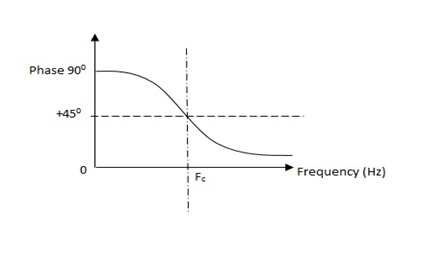
FC = 
Phase shift = Cot 
VO =Vi
VO = Vi
At low F: XC ->∞ VO = 0
At high F: XC -> 0 VO = Vi
Q. An RC HPF with input capacitor 10nf and the output resistor of 10K Ω. Find the cut off frequency.

Sol:
FC = =
= 
FC = 15.915 Hz
Q. Calculate the break point (FC) for a simple passive HPF consisting of 82pF capacitor connected in series with 240 KΩ resistor?

Sol:
FC = =
= 
FC = 8KHz
(b). RL – HPF:
The basic RL HPF is shown below. The inductors pass low frequency signals with very little resistance, and offers great resistance to high frequency signals.
VO = 
FC = 

Q. For a RL HPF consists of 470Ω resistor and 600 mH coil output is taken across coil. Calculate the cut off frequencies.
Sol:
FC =  =
= = 125 Hz
= 125 Hz
Band Pass and Band reject proto- type section
It can be designed by making a series connection of HPF with a LPF. The Basic circuit is shown below.

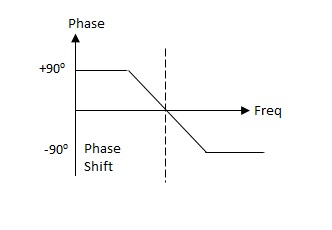
Fig. Frequency response and phase shift Put
FC = 1 / 2∏RC C2 = 1 / 2∏FHR
C1 = 1 / 2∏FLR FR = 
FL = lower -3dB cut off frequency
FH= upper -3dB cut off frequency
Band width (BW) = FH - FL
USES
1>. The BPF has its applications in wireless communication at transmitter and receiver.
2>. It is also used in optical communication.
3>. For reducing the signal to noise ratio at the receiving end.
Q. The value of capacitor C1 required to give a cut off frequency fL = 1KHz and value of resistor is 10K for the BPF. The value of capacitor C2 and higher cut off frequency (FH) is 30 KHz with resistor 10KΩ. Also calculate the central resonat frequency?
Sol: Given values for HPF
FL = 1000 Hz, R1 = 10 x 103Ω
C1 =  =
= = 15.9nF
= 15.9nF
For LPF,
FH = 30 x 103 Hz, R2 = 10 x 103Ω
C2 = =
= = 530nF
= 530nF
Central resonat frequency,
Fr = 
= 
Fr = 5.477 KHz
Band Stop Filter (BSF) OR Notch FILTER
A notch filter is a Band Stop filter with a narrow band stop bandwidth. These filter are used to attenuate a narrow range of frequencies.

FC = 1 / 2∏RC or FR = 
R = 1 / 2∏FCC
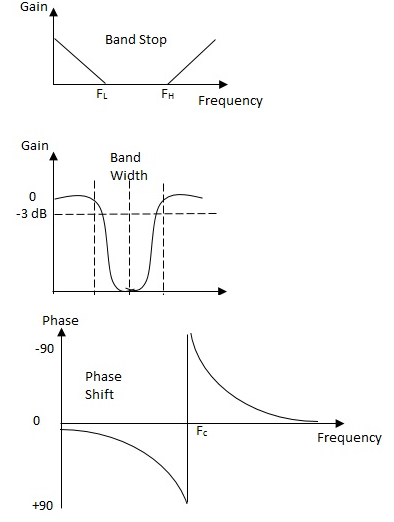
Applications of BSF
(i). In telephone technology it is used as noise reducer.
(ii). Widely used in guitar amplifiers.
(iii). For reducing unwanted harmonics.
(iv). Used to reduce static on radio.
(v). In image signal processing.
(vi). Used in biometric instruments like ECG for removing line noise.
Calculation of some basic parameters for T and ∏ section filters
Basic circuit for the calculation of few parameters such as impedance (Zo), and attenuation and phase constants shown below. Here we consider a symmetrical network.

(i). Calculating Zo for T – section fig (a).
Zo = 
Z0 =  +
+
4Z20 + 4Z2Z0 + 2Z1Z0 = Z21 + 4Z1Z2 + 2Z0Z1 + 4Z0Z2
4Z02 = Z12 + 4Z1Z2
Z02 = Z12/4 + Z1Z2
For T-section Z0T = -(1)
-(1)
(ii). Calculating same for ∏-section network
Zo=
Z0 =
4Z1Z22 = Z02Z1 + 4Z02Z2
Z02 = 
Z0∏ =  - (2)
- (2)
From (1) & (2)
Z0T.Z0∏ = Z1Z2
(iii). Attenuation and phase constant for symmetrical T-section shown below.

Applying KVL,
V = I1( +
+ ) – I2Z2
) – I2Z2
0 = -I1Z2 + I2( + Z2 + Z0)
+ Z2 + Z0)

Let  = eᵞ
= eᵞ
Where ᵞ = Propagation constant
ᵞ = α + jβ
α: attenuation constant(nepers)
β: phase constant(radians)
eᵞ = 
Z0 = Z2(eᵞ - 1)- 
But from eqn (1)
ZOT2 = Z12/4 + Z1Z2
Eliminating Z0 we get
Z2(eᵞ- 1)2 – Z2 eᵞ = 0
 = 1 +
= 1 + 
Coshᵞ = 1 + 
Since, Sinh =
=
Sinh =
= 
Sinh =
=  - (3)
- (3)
But ᵞ = α + jβ
Sinh( +
+  )=
)= 
Expanding above equation
Sinh . Cos
. Cos + jCosh
+ jCosh . Sin
. Sin =
= 
When Sinh . Cos
. Cos = 0
= 0
α = 0, β≠ 0. Sin =
= 
For pass band
α = 0, β = 2Sin-1 | - (4)
| - (4)
When cos  = 0
= 0
α≠ 0, β = (2n - 1) ∏
Cosh  =
= 
For Stop Band :
α = 2 cos h-1 , β = ∏ - (5)
, β = ∏ - (5)
For such filters the shunt(Z2) and series(Z1) impedances are related as Z1Z2 = K2 = R02

Where k is a constant independent of frequency.
The prototype LPF having symmetrical T and ∏ section is shown below.
(i). Cut off frequency – For both networks
Z1 = jwL, Z2 = 1/jwc
Z1Z2 = L/c = K2 = R02
R0 = √L/C - (6)
So, cut off frequency is given when,
Z1 = 0 and Z1 + 4Z2 = 0
Jw4 = 0 (Wc = 0)
Z1 + 4Z2 = 0
JWcL + 4/jWcC = 0
Wc = 2/√LC (WC = 2∏Fc)
Fc = 1/∏√LC - (7)
(ii). Attenuation constant & Phase Constant
α = 0 ( in pass band )
α = 2Cosh-1√|Z1/4Z2| - ( in stop band )
Substituting Z1 and Z2
α = 2Cosh-1(F/Fc) - (8)
β = ∏ ( in stop band )
β = 2Sin-1√|Z1/4Z2| - ( for pass band )
β = 2Sin-1√F/Fc - (9)
(iii). Characteristic Impedance for T section and ∏ section
As we already know from equation (1)
ZT = √Z1Z2(1+Z1/4Z2)
Substituting Z1 and Z2
ZOT = √L/C + (1 + jwL/4Ljwc)
= √L/C√1-(F/Fc)2
ZOT = Ro√1-(F/Fc)2 - (10)
From eq (2) we have
ZO∏ = √Z1Z2/1 + Z1/4Z2
Substituting Z1 and Z2 we have
= √4C/1 – w2/LC/4
ZO∏ = Ro/√1-(F/Fc)2 - (11)
m-derived T and ∏ section LPF
F∞ = 1/∏√LC√1-m2 , F∞ = FC/√1-m2
FC = 1/∏√LC
m = √1 – (FC/F∞)2
Constant K HPF
Basic circuit configuration for constant –k HPF for T section & ∏ section is shown below.

(i). Attenuation & Phase Constant:-
α = 0 ( for pass band )
α = 2Cosh-1√|Z1/4Z2| - ( for stop band )
α = 2Cosh-1(Fc/F) - (12)
β = ∏ ( for stop band )
β = 2Sin-1√|Z1/4Z2| - ( for pass band )
β = 2Sin-1(Fc/F) - (13)
(ii). Cut off frequency :-
Z1 + 4Z0 = 0, or Z1 = 0
4jWcL + 1/jWcC = 0
Wc = 1/2√LC
Fc = 1/4∏√LC - (14)
(iii). Calculation of ZOT and ZO∏ -
ZOT = √Z1Z2(1 + Z1/4Z2)
Z1 = 1/jwc, Z2 = jwL
Substituting above Z1 & Z2 and simplifying,
ZOT = RO√1 – (Fc/F)2 -(15)
From equation (2), we have,
ZO∏ = √Z1Z2/1 + Z1/4Z2
Again substituting Z1, Z2 and simplifying,
ZO∏ = RO/√1 – (Fc/F)2
Q – Design a constant K LPF T and ∏ section filter having Fc = 1000Hz and nominal characteristic impedance R0 = 400Ω. Also determine the frequency for this filter with attenuation of 19.1 dB.
Sol: FC = 1000 Hz, R0 = 400Ω
FC = 1/∏√Lc, R0 = √L
R0/Fc = √LC/1/∏√LC
R0/Fc = ∏L
L = 400/∏ x 1000 = 127.32 mH
C = 1/∏FCRo = 1/∏ x 1000 x 400 = 0.795 µF
Attenuation in dB = 8.686 x Attenuation in nepers
Attenuation in nepers = 2.2 nepers
α = 2Cosh-1(F/FC)
F/2 = Cosh(1.1)
F = 3.3 KHz
The design of required filter for T and ∏ section with values L = 127.32 mH. C = 0.795µF is shown below.
m-derived HPF:
F∞ = √1 - m2FC
m = √1 – (F∞/FC)2
FC = 1/4∏√LC
Constant K BPF
It is series combination of LPF with an HPF. Which pass a particular band of frequency. The basic structure network of BPF is shown below.
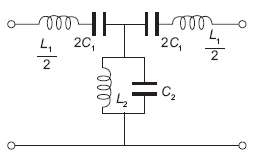
Considering the above circuit, we again calculate few basic parameters related to the circuit.
(i). Ro
In order to allow existence of at least one pass band we assume
Wo2L1C1 = 1 and W02L22C2 = 1
L1C1 = L2C2 = 1/W02 - (16)
Z1 = jwL1 + 1/jWC1 = -W2L1C1 + 1/jWC1
Z2 = jwL2 x 1/jWC2 / jwL2 + 1/jWC2
Z2 = jwL2 / 1 – W2L2C2
But, R02 = Z1Z2
R02 = (jW2L1C1 – 1 / WC1) x (jWL2 / 1 – W2L2C2)
= L2/C1(1 – W2L1C1/1-W2L2C2)
R02 = L2/C1 = Z1Z2
R0 = √L2/C1 = √L1/C2 - (17)
(ii). For cut off frequency we already know
Z1 + 4Z2 = 0
Z1 = -4Z2
Z12 = -4Z1Z2
Z12 = -4R02 ( Since Z1Z2 = R02 )
Z1 = +-j2R0
Z1 = -2jR0 , Z2 = +2jR0
( at F = F1 ) ( at F = F2 )
The impedance Z1 is negative of Z2 so,
Z1 = -Z2
j(WL1 – 1/WC1)F=F1 = [ -jWL1 + 1/jWC1 ]F=F2
1 – W12L1C1 = W1/W2(W22L1C1 - 1)
But L1C1 = 1/W02 and W0 = 2∏FC
1 – (F1/F0)2 = F1/F2[ (F2/F0)2 - 1 ]
F2(F02 – F12) = F1(F22 – F02)
F02 = F1F2
F0 = √F1F2 - (18)
(iii). Calculating filter components L1, C1, L2, C2.
As we already know that at F = F1, Z1 = -2jR0.
JW1L1 + 1/jW1C1 = -2jR0
Rearranging and solving above equation,
-(1 – W12L1C1)/W1C1 = -2jR0
1 – (W1/W0)2 = 2R0W1C1(W02 – 1/L1C1)
1 – (F1/F0)2 = 4∏R0F1C1
But F0 = √F1F2
1 – F12/F1F2 = 4∏R0F1C1
C1 = F2 – F1/ 4∏R0F1F2 - (19)
L1C1 = 1/42
L1 = R0/∏(F2 – F1) - (20)
L1C1 = L2C2 = 1/42
L2/C1 = R02
L2 = R02(F2 – F1)/ 4∏R0F1F2 = R0(F2 – F1)/ 4∏F1F2 - (21)
C2 = L2/R02
C2 = 1/ ∏R0(F2 – F1) - (22)
Q – Design a constant K BPF with FC = 4KHz and 7KHz and R0 = 500Ω.
Sol: Given:
FC1 = 4000Hz, FC2 = 7000Hz
For BPF,
L1 = R0/ ∏ (F2 – F1) = 500/∏ (7000 – 4000) = 53.05 mH
C1 = F2 – F1/4∏R0F1F2 = 7000 – 4000 / 4∏ x 500 x 7000 x 4000 = 0.017µF
L2 = R0(F2-F1)/ 4∏F1F2 = 500(7000 - 4000) / 4∏ (7000 x 4000) = 42.63 mH
C2 = 1/R0∏ (F2 - F1) = 1/500 x ∏ (7000 - 4000) = 0.212 µF
m-derived BPF:
L1C1 = L2C2 = 1/W02
Infinite attenuation
F∞2 - F∞1 = F2 – F1 / √(1-m2)
m = √1 – (F2 – F1 / F∞2 - F∞1)
Constant k- band stop filter
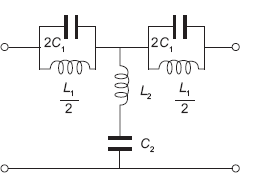
In a constant k band stop filter the components L1, C1 and L2 C2 are chosen such that the shunt resonant frequency of the series arm equals the series resonant frequency of the shunt arm. This frequency is called resonant frequency or the centre frequency f0. Therefore,
i) Characteristics Impedance
Wo2L1C1 = 1 and W02L22C2 = 1
L1C1 = L2C2 = 1/W02
Z1 = (jWL1/ jWC1)/[ jWL1+(1/ jWC1)]= jWL1/1-W2L1C1
Z2 = jWL2+(1/ jWC2) = jW2L2C2-1/WC2
Since L1C1=L2C2
Z1Z2 = R02
R0 = √L2/C1 = √L1/C2
Ii) Cut-off Frequencies
Z1 + 4Z2 = 0
Z1 = -4Z2
Z12 = -4Z1Z2
Z12 = -4R02 ( Since Z1Z2 = R02 )
Z1 = +-j2R0
Z1 = -2jR0 , Z2 = +2jR0
The simplification is now done in same way as in case of BPF
F0 = √F1F2
Iii) Filter Component Value
The component values at lower cut-off frequencies are given as
L1= (f2-f1)R0/πf1f2
L2=R0/4π(f2-f1)
C1=1/R04π(f2-f1)
C2=(f2-f1)/ πR0 f1f2
m-derived Band stop filter:
Infinite attenuation occurs when
F∞2 - F∞1 = (F2 – F1) √(1-m2)
m = √1 – (F∞2 - F∞1 / F2 – F1)2
Q – Design a constant – k BSF with cut-off frequency of 3KHz and 8KHz and R0 = 600Ω
Sol: F1 = 3000Hz, F2 = 8000Hz, R0 = 600 Ω
L1 = (F2 – F1) R0 / ∏F1F2 = (8000 - 3000) x 600 / ∏ x 8 x 3 x 106 = 5 x 6 x 105 / ∏ x 8 x 3 x 106
L1 = 39.79mH
C1 = 1/4∏R0(F2 – F1) = 1/4∏ x 600(5000) = 0.0265µF
L2 = R0/4∏ (F2 – F1) = 600/4∏ (5000) = 9.54 x 10-3 H
C2 = F2 – F1 / ∏R0F1F2 = 5000 / ∏ x 600 x 8000 x 3000 = 1.105 x 10-3 H
L1/2 = 19.89mH, 2C1 = 0.053 µF
References:
[1] Network Analysis Third Edition by M. E. Van Valkenburg, Prentice Hall of India Private Limited.
[2] Network Analysis & Synthesis by G. K. Mittal, Khanna Publication.
[3] Network Analysis and Synthesis by Ravish R Singh, McGraw Hill.
[4] Introduction to Electric Circuits by Alexander & Sadiku, McGraw Hill.
[5] Introduction to Electric Circuits by S. Charkarboorty, Dhanpat Rai & Co.
[6] Fundamentals of Electrical Networks by B.R.Gupta & Vandana Singhal- S.Chand Publications
[7] Electrical Circuit Analysis 2nd Edition by P. Ramesh babu, Scitech Publication
India Pvt Ltd.